CHEVROLET CAMARO 1967 1.G Chassis Workshop Manual
Manufacturer: CHEVROLET, Model Year: 1967, Model line: CAMARO, Model: CHEVROLET CAMARO 1967 1.GPages: 659, PDF Size: 114.24 MB
Page 171 of 659
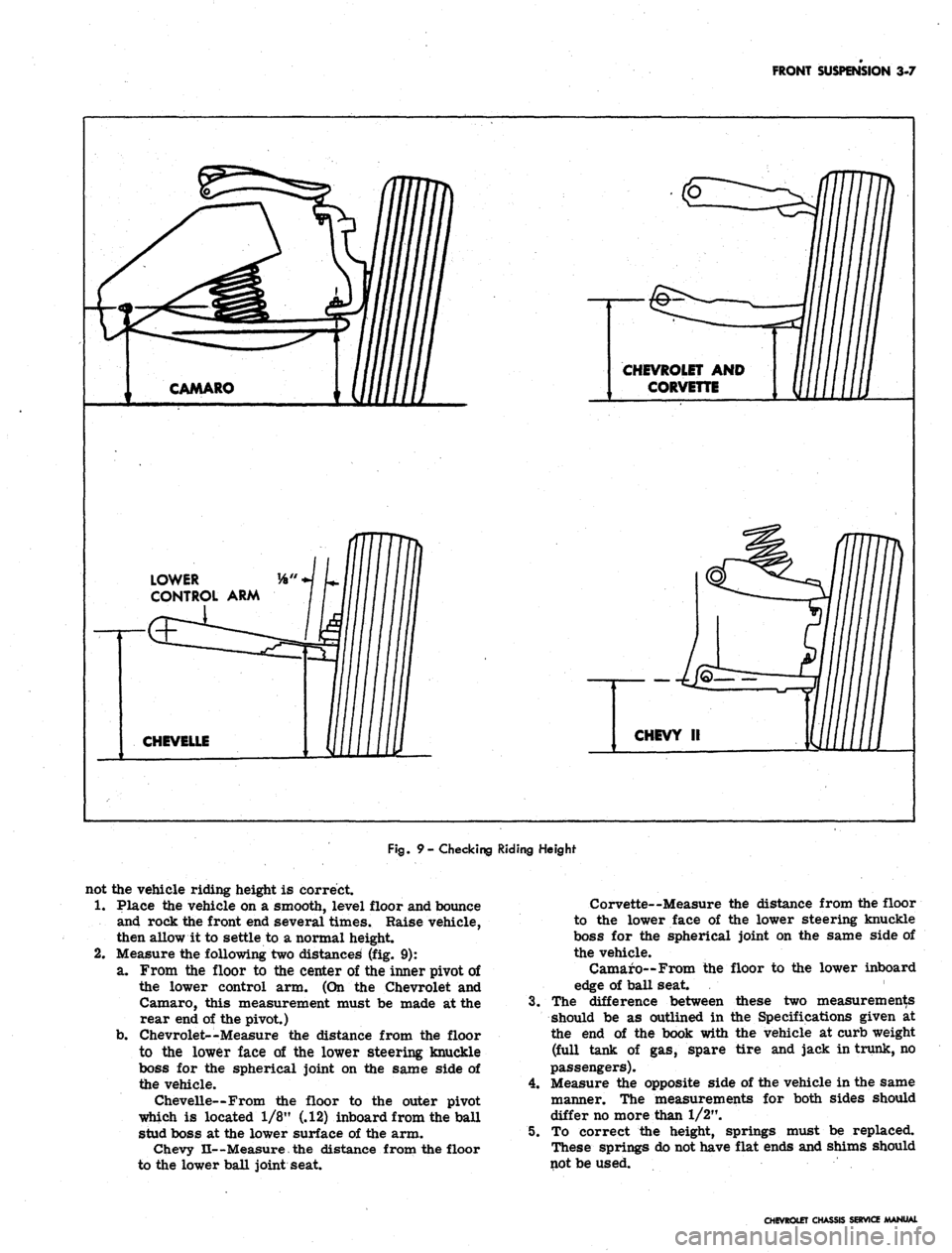
FRONT SUSPENSION 3-7
CAMARO
CHEVROLET
AND
CORVETTE
LOWER
CONTROL
ARM
CHEVELLE
CHEVY
II
Fig.
9- Checking Riding Height
not the vehicle riding height is correct.
1.
Place the vehicle on a smooth, level floor and bounce
and rock the front end several times. Raise vehicle,
then allow it to settle to a normal height.
2.
Measure the following two distances (fig. 9):
a. From the floor to the center of the inner pivot of
the lower control arm. (On the Chevrolet and
Camaro, this measurement must be made at the
rear end of the pivot.)
b.
Chevrolet--Measure the distance from the floor
to the lower face of the lower steering knuckle
boss for the spherical joint on the same side of
the vehicle.
Chevelle—From the floor to the outer pivot
which is located 1/8" (.12) inboard from the ball
stud boss at the lower surface of the arm.
Chevy II--Measure the distance from the floor
to the lower ball joint seat.
Corvette—Measure the distance from the floor
to the lower face of the lower steering knuckle
boss for the spherical joint on the same side of
the vehicle.
Camaro—From the floor to the lower inboard
edge of ball seat.
3.
The difference between these two measurements
should be as outlined in the Specifications given at
the end of the book with the vehicle at curb weight
(full tank of gas, spare tire and jack in trunk, no
passengers).
4.
Measure the opposite side of the vehicle in the same
manner. The measurements for both sides should
differ no more than 1/2".
5. To correct the height, springs must be replaced.
These springs do not have flat ends and shims should
not be used.
CHEVROLET CHASSIS SERVICE MANUAL
Page 172 of 659
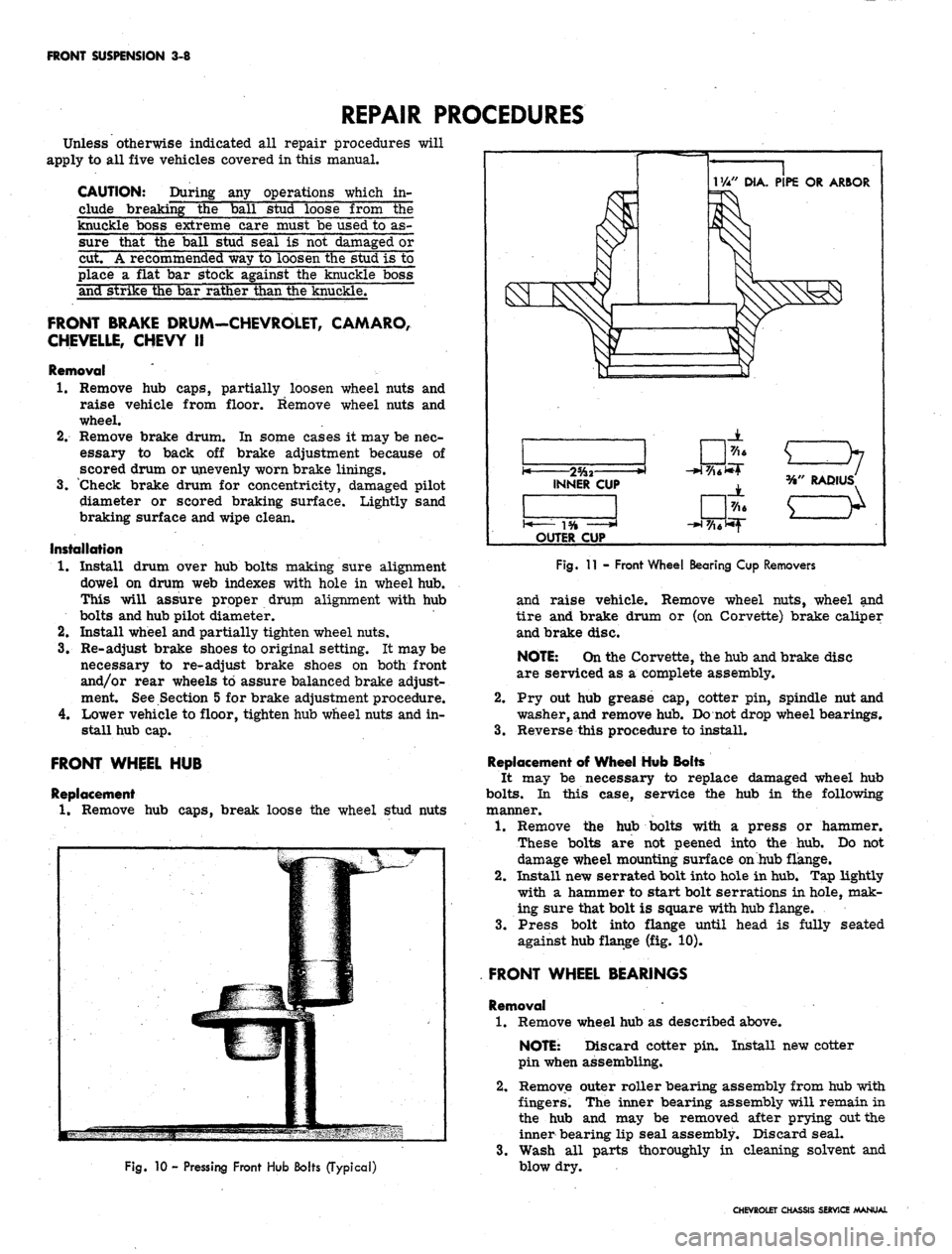
FRONT SUSPENSION 3-8
REPAIR PROCEDURES
Unless otherwise indicated all repair procedures will
apply to all five vehicles covered in this manual.
CAUTION: During any operations which in-
clude breaking the ball stud loose from the
knuckle boss extreme care must be used to as-
sure that the ball stud seal is not damaged or
cut. A recommended way to loosen the stud is to
place a flat bar stock against the knuckle boss
and strike the bar rather than the knuckle.
FRONT BRAKE DRUM-CHEVROLET, CAMARO,
CHEVELLE, CHEVY It
Removal
1.
Remove hub caps, partially loosen wheel nuts and
raise vehicle from floor. Remove wheel nuts and
wheel.
2.
Remove brake drum. In some cases it may be nec-
essary to back off brake adjustment because of
scored drum or unevenly worn brake linings.
3.
Check brake drum for concentricity, damaged pilot
diameter or scored braking surface. Lightly sand
braking surface and wipe clean.
Installation
1.
Install drum over hub bolts making sure alignment
dowel on drum web indexes with hole in wheel hub.
This will assure proper drum alignment with hub
bolts and hub pilot diameter.
2.
Install wheel and partially tighten wheel nuts.
3.
Re-adjust brake shoes to original setting. It may be
necessary to re-adjust brake shoes on both front
and/or rear wheels to assure balanced brake adjust-
ment. See Section 5 for brake adjustment procedure.
4.
Lower vehicle to floor, tighten hub wheel nuts and in-
stall hub cap.
FRONT WHEEL HUB
Replacement
1.
Remove hub caps, break loose the wheel stud nuts
VM" DIA. PIPE OR ARBOR
>l
INNER CUP
OUTER CUP
JL
RADIUS
e^
Fig.
10 - Pressing Front Hub Bolts (Typical)
Fig.
11 - Front Wheel Bearing Cop Removers
and raise vehicle. Remove wheel nuts, wheel and
tire and brake drum or (on Corvette) brake caliper
and brake disc.
NOTE:
On the Corvette, the hub and brake disc
are serviced as a complete assembly.
2.
Pry out hub grease cap, cotter pin, spindle nut and
washer,
and
remove hub. Do not drop wheel bearings.
3.
Reverse this procedure to install.
Replacement of Wheel Hub Bolts
It may be necessary to replace damaged wheel hub
bolts.
In this case, service the hub in the following
manner.
1.
Remove the hub bolts with a press or hammer.
These bolts are not peened into the hub. Do not
damage wheel mounting surface on hub flange.
2.
Install new serrated bolt into hole in
hub.
Tap lightly
with a hammer to start bolt serrations in hole, mak-
ing sure that bolt is square with hub flange.
3.
Press bolt into flange until head is fully seated
against hub flange (fig. 10).
FRONT WHEEL BEARINGS
Removal '
1.
Remove wheel hub as described above.
NOTE: Discard cotter pin. Install new cotter
pin when assembling.
2.
Remove outer roller bearing assembly from hub with
fingers. The inner bearing assembly will remain in
the hub and may be removed after prying out the
inner bearing lip seal assembly. Discard seal.
3.
Wash all parts thoroughly in cleaning solvent and
blow dry.
CHEVROLET CHASSIS SERVICE MANUAL
Page 173 of 659
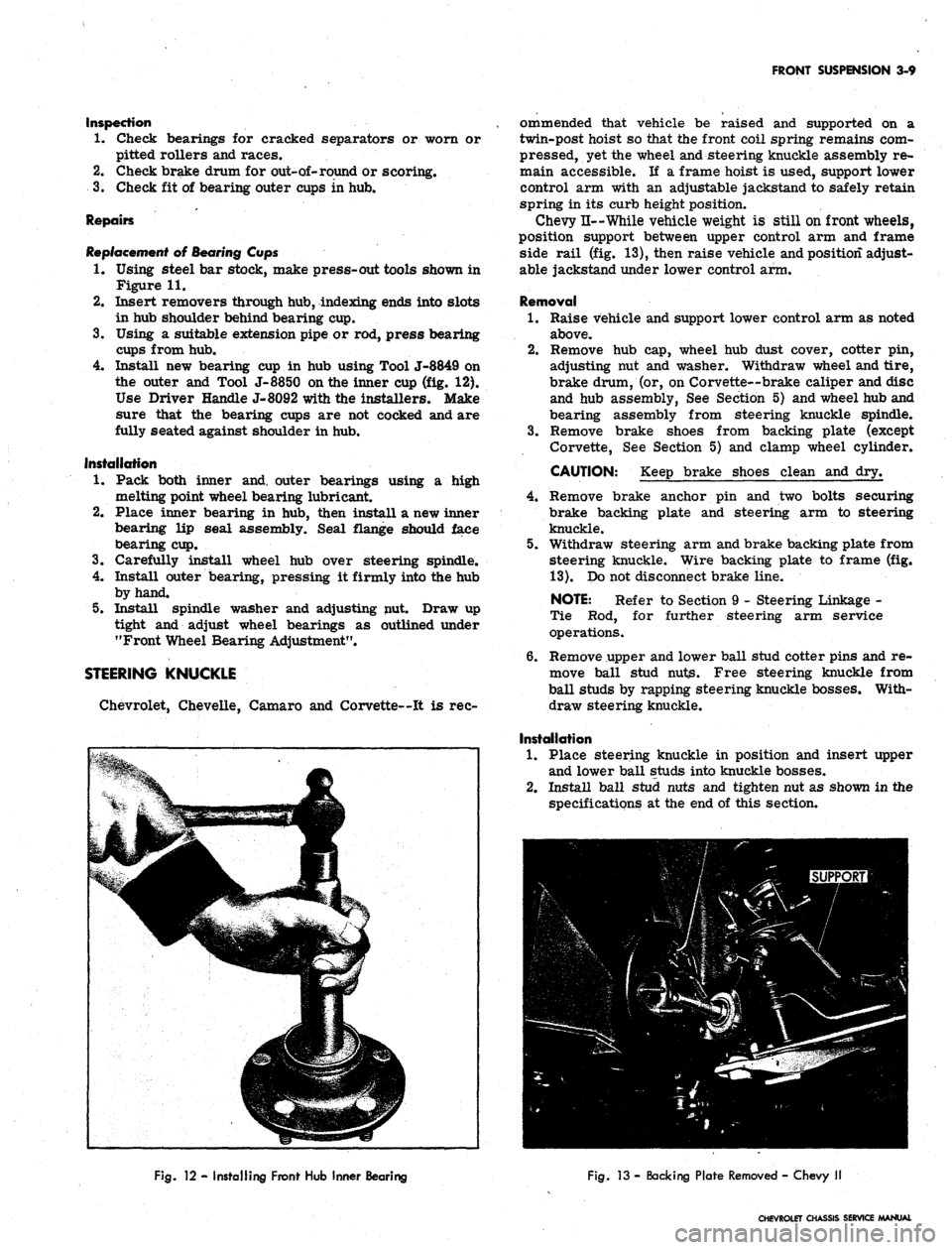
FRONT SUSPENSION 3-9
Inspection
1.
Check bearings for cracked separators or worn or
pitted rollers and races.
2.
Check brake drum for
out-of-
round or scoring.
3.
Check fit of bearing outer cups in hub.
Repairs
Replacement of Bearing Cups
1.
Using steel bar stock, make press-out tools shown in
Figure 11.
2.
Insert removers through hub, indexing ends into slots
in hub shoulder behind bearing cup.
3.
Using a suitable extension pipe or rod, press bearing
cups from hub.
4.
Install new bearing cup in hub using Tool J-8849 on
the outer and Tool J-8850 on the inner cup (fig. 12).
Use Driver Handle J-8092 with the installers. Make
sure that the bearing cups are not cocked and are
fully seated against shoulder in hub.
Installation
1.
Pack both inner and. outer bearings using a high
melting point wheel bearing lubricant.
2.
Place inner bearing in hub, then install a new inner
bearing lip seal assembly. Seal flange should face
bearing cup.
3.
Carefully install wheel hub over steering spindle.
4.
Install outer bearing, pressing it firmly into the hub
by hand.
5.
Install spindle washer and adjusting nut. Draw up
tight and adjust wheel bearings as outlined under
"Front Wheel Bearing Adjustment".
STEERING KNUCKLE
Chevrolet, Chevelle, Camaro and Corvette—It is rec-
ommended that vehicle be raised and supported on a
twin-post hoist so that the front coil spring remains com-
pressed, yet the wheel and steering knuckle assembly re-
main accessible. If a frame hoist is used, support lower
control arm with an adjustable jackstand to safely retain
spring in its curb height position.
Chevy n— While vehicle weight is still on front wheels,
position support between upper control arm and frame
side rail (fig. 13), then raise vehicle and position adjust-
able jackstand under lower control arm.
Removal
1.
Raise vehicle and support lower control arm as noted
above.
2.
Remove hub cap, wheel hub dust cover, cotter pin,
adjusting nut and washer. Withdraw wheel and tire,
brake drum, (or, on Corvette--brake caliper and disc
and hub assembly, See Section 5) and wheel hub and
bearing assembly from steering knuckle spindle.
3.
Remove brake shoes from backing plate (except
Corvette, See Section 5) and clamp wheel cylinder.
CAUTION: Keep brake shoes clean and dry.
4.
Remove brake anchor pin and two bolts securing
brake backing plate and steering arm to steering
knuckle.
5.
Withdraw steering arm and brake backing plate from
steering knuckle. Wire backing plate to frame (fig.
13).
Do not disconnect brake line.
NOTE: Refer to Section 9 - Steering Linkage -
Tie Rod, for further steering arm service
operations.
6. Remove upper and lower ball stud cotter pins and re-
move ball stud nuts. Free steering knuckle from
ball studs by rapping steering knuckle bosses. With-
draw steering knuckle.
Installation
1.
Place steering knuckle in position and insert upper
and lower ball studs into knuckle bosses.
2.
Install ball stud nuts and tighten nut as shown in the
specifications at the end of this section.
Fig.
12 - Installing Front Hub Inner Bearing
Fig.
13 - Backing Plate Removed - Chevy II
CHEVROLET CHASSIS SERVICE MANUAL
Page 174 of 659
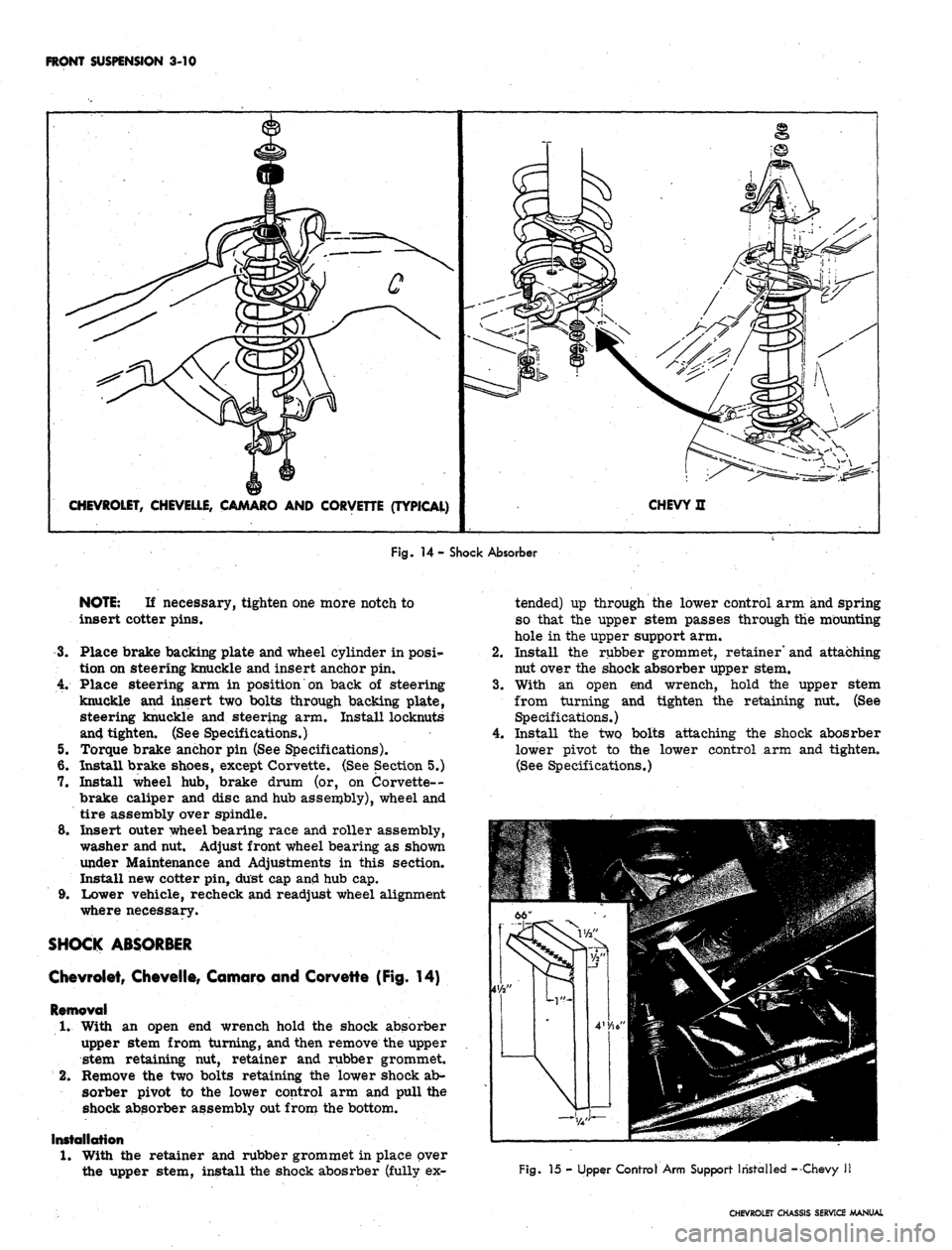
FRONT SUSPENSION 3-10
CHEVROLET, CHEVELLE, CAMARO AND CORVETTE (TYPICAL)
CHEVY H
Fig.
14- Shock Absorber
NOTE:
If necessary, tighten one more notch to
insert cotter pins.
3.
Place brake backing plate and wheel cylinder in posi*-
tion on steering knuckle and insert anchor pin.
4.
Place steering arm in position on back of steering
knuckle and insert two bolts through backing plate,
steering knuckle and steering arm. Install locknuts
and tighten. (See Specifications.)
5. Torque brake anchor pin (See Specifications).
6. Install brake shoes, except Corvette. (See Section 5.)
7. Install wheel hub, brake drum (or, on Corvette--
brake caliper and disc and hub assembly), wheel and
tire assembly over spindle.
8. Insert outer wheel bearing race and roller assembly,
washer and nut. Adjust front wheel bearing as shown
under Maintenance and Adjustments in this section.
Install new cotter pin, dust cap and hub cap.
9. Lower vehicle, recheck and readjust wheel alignment
where necessary.
SHOCK ABSORBER
Chevrolet, Chevelle, Comoro and Corvette (Fig. 14)
Removal
1.
With an open end wrench hold the shock absorber
upper stem from turning, and then remove the upper
stem retaining nut, retainer and rubber grommet.
2.
Remove the two bolts retaining the lower shock ab-
sorber pivot to the lower control arm and pull the
shock absorber assembly out from the bottom.
Installation
1.
With the retainer and rubber grommet in place over
the upper stem, install the shock abosrber (fully ex-
tended) up through the lower control arm and spring
so that the upper stem passes through the mounting
hole in the upper support arm.
2.
Install the rubber grommet, retainer' and attaching
nut over the shock absorber upper stem.
3.
With an open end wrench, hold the upper stem
from turning and tighten the retaining nut. (See
Specifications.)
4.
Install the two bolts attaching the shock abosrber
lower pivot to the lower control arm and tighten.
(See Specifications.)
Fig.
15 - Upper Control Arm Support Installed - Chevy II
CHEVROLET CHASSIS SERVICE MANUAL
Page 175 of 659
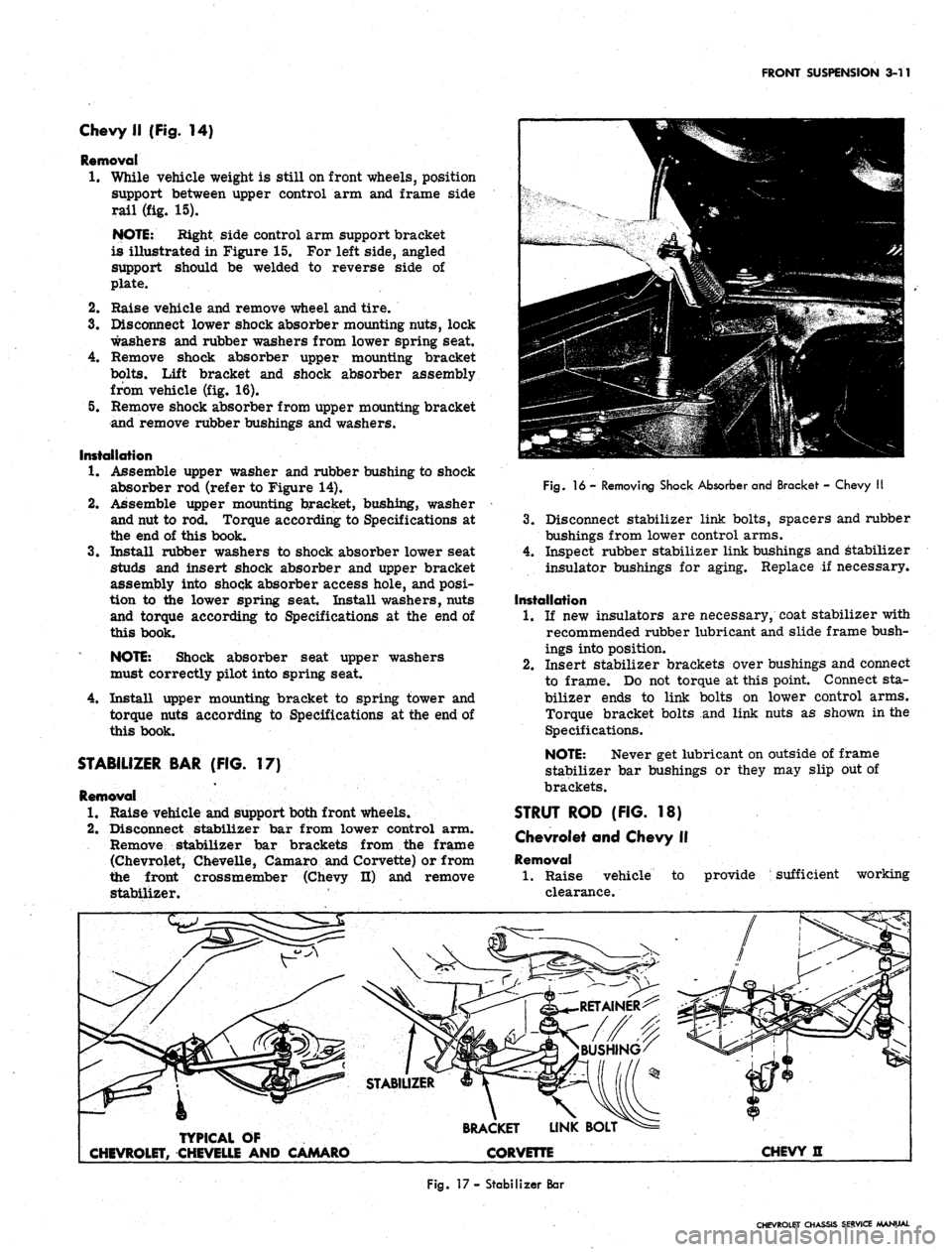
FRONT SUSPENSION 3-11
Chevy II (Fig. 14)
Removal
1.
While vehicle weight is still on front wheels, position
support between upper control arm and frame side
rail (fig. 15).
NOTE: Bight side control arm support bracket
is illustrated in Figure 15. For left side, angled
support should be welded to reverse side of
plate.
2.
Raise vehicle and remove wheel and tire.
3.
Disconnect lower shock absorber mounting nuts, lock
washers and rubber washers from lower spring seat.
4.
Remove shock absorber upper mounting bracket
bolts.
Lift bracket and shock absorber assembly
from vehicle (fig. 16).
5.
Remove shock absorber from upper mounting bracket
and remove rubber bushings and washers.
Installation
1.
Assemble upper washer and rubber bushing to shock
absorber rod (refer to Figure 14).
2.
Assemble upper mounting bracket, bushing, washer
and nut to rod. Torque according to Specifications at
the end of this book.
3.
Install rubber washers to shock absorber lower seat
studs and insert shock absorber and upper bracket
assembly into shock absorber access hole, and posi-
tion to the lower spring seat. Install washers, nuts
and torque according to Specifications at the end of
this book.
NOTE: Shock absorber seat upper washers
must correctly pilot into spring seat.
4.
Install upper mounting bracket to spring tower and
torque nuts according to Specifications at the end of
this book.
STABILIZER BAR (FIG. 17)
Removal
1.
Raise vehicle and support both front wheels.
2.
Disconnect stabilizer bar from lower control arm.
Remove stabilizer bar brackets from the frame
(Chevrolet, Chevelle, Camaro and Corvette) or from
the front crossmember (Chevy n) and remove
stabilizer.
Fig.
16 - Removing Shock Absorber and Bracket - Chevy II
3.
Disconnect stabilizer link bolts, spacers and rubber
bushings from lower control arms.
4.
Inspect rubber stabilizer link bushings and Stabilizer
insulator bushings for aging. Replace if necessary.
Installation
1.
If new insulators
are necessary, coat stabilizer with
recommended rubber lubricant and slide frame bush-
ings into position.
2.
Insert stabilizer brackets over bushings and connect
to frame. Do not torque at this point. Connect sta-
bilizer ends to link bolts on lower control arms.
Torque bracket bolts and link nuts as shown in the
Specifications.
NOTE: Never get lubricant on outside of frame
stabilizer bar bushings or they may slip out of
brackets.
STRUT ROD (FIG. 18)
Chevrolet and Chevy II
Removal
1.
Raise vehicle to
clearance.
provide sufficient working
TYPICAL OF
CHEVROLET, CHEVELLE AND CAMARO
BRACKET LINK BOLT
CORVETTE
CHEVY H
Fig.
17- Stabilizer Bar
CHEVROLET CHASSIS SERVICE MANUAL
Page 176 of 659
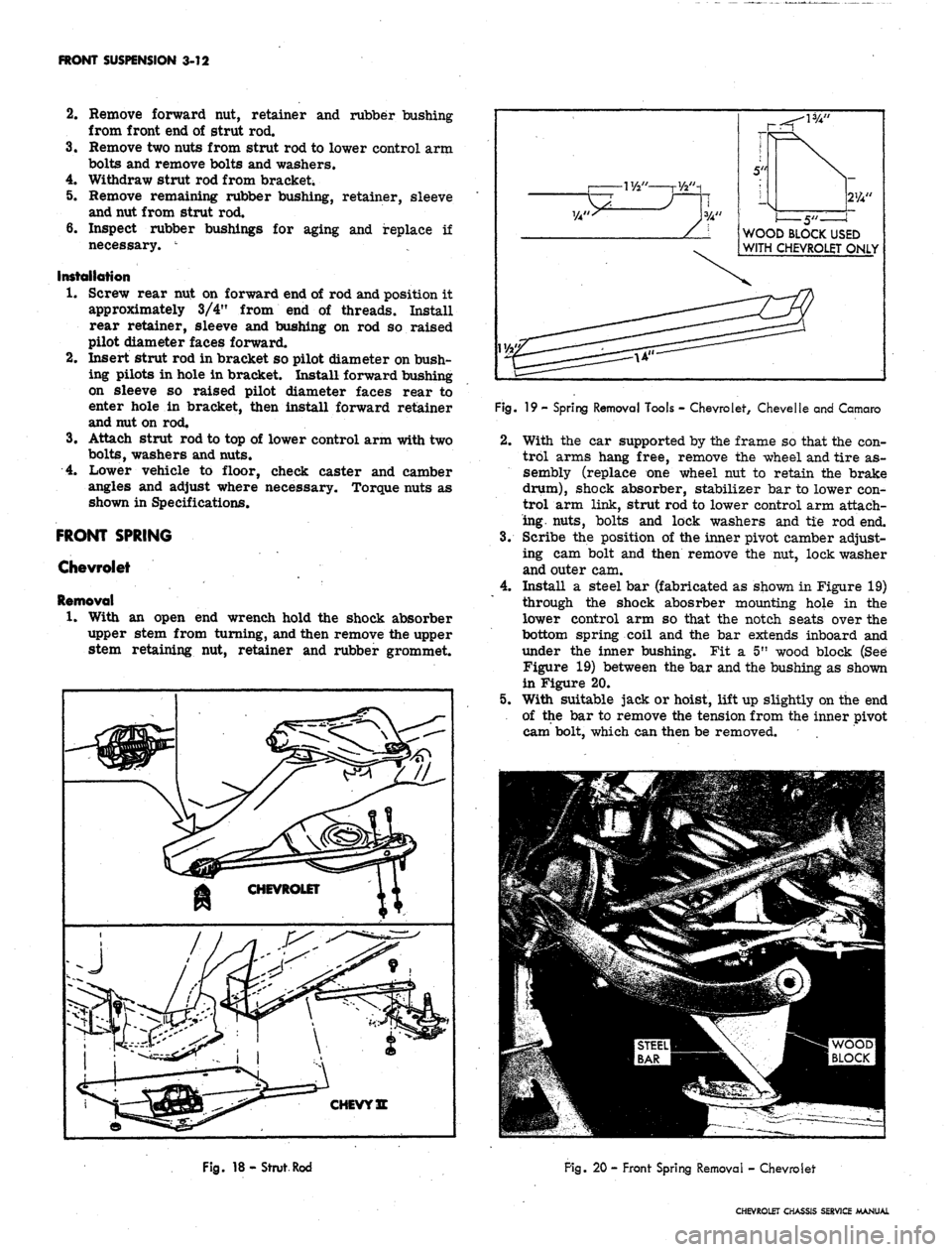
FRONT SUSPENSION 3-12
2.
Remove forward nut, retainer and rubber bushing
from front end of strut rod.
3.
Remove two nuts from strut rod to lower control arm
bolts and remove bolts and washers.
4.
Withdraw strut rod from bracket.
5. Remove remaining rubber bushing, retainer, sleeve
and nut from strut rod.
6. Inspect rubber bushings for aging and replace if
necessary. *•
Installation
1.
Screw rear nu$ on forward end of rod and position it
approximately 3/4" from end of threads. Install
rear retainer, sleeve and bushing on rod so raised
pilot diameter faces forward.
2.
Insert strut rod in bracket so pilot diameter on bush-
ing pilots in hole in bracket. Install forward bushing
on sleeve so raised pilot diameter faces rear to
enter hole in bracket, then install forward retainer
and nut on rod.
3.
Attach strut rod to top of lower control arm with two
bolts,
washers and nuts.
4.
Lower vehicle to floor, check caster and camber
angles and adjust where necessary. Torque nuts as
shown in Specifications.
FRONT SPRING
Chevrolet
Removal
1.
With an open end wrench hold the shock absorber
upper stem from turning, and then remove the upper
stem retaining nut, retainer and rubber grommet.
I IVi" rVi"i
\>. j ii
>
I
5'4
s
WOOD
BLOCK
USED
WITH
CHEVROLET
ONLY
Fig.
19
- Spring Removal Tools - Chevrolet, Chevelle and Comoro
2.
With the car supported by the frame so that the con-
trol arms hang free, remove the wheel and tire as-
sembly (replace one wheel nut to retain the brake
drum),
shock absorber, stabilizer bar to lower con-
trol arm link, strut rod to lower control arm attach-
ing, nuts, bolts and lock washers and tie rod end.
3.
Scribe the position of the inner pivot camber adjust-
ing cam bolt and then remove the nut, lock washer
and outer cam.
4.
Install a steel bar (fabricated as shown in Figure 19)
through the shock abosrber mounting hole in the
lower control arm so that the notch seats over the
bottom spring coil and the bar extends inboard and
under the inner bushing. Fit a 5" wood block (See
Figure 19) between the bar and the bushing as shown
in Figure 20.
5.
With suitable jack or hoist, lift up slightly on the end
of the bar to remove the tension from the inner pivot
cam bolt, which can then be removed.
Fig.
18-Strut Rod
Pig. 20 - Front Spring Removal - Chevrolet
CHEVROLET CHASSIS SERVICE MANUAL
Page 177 of 659
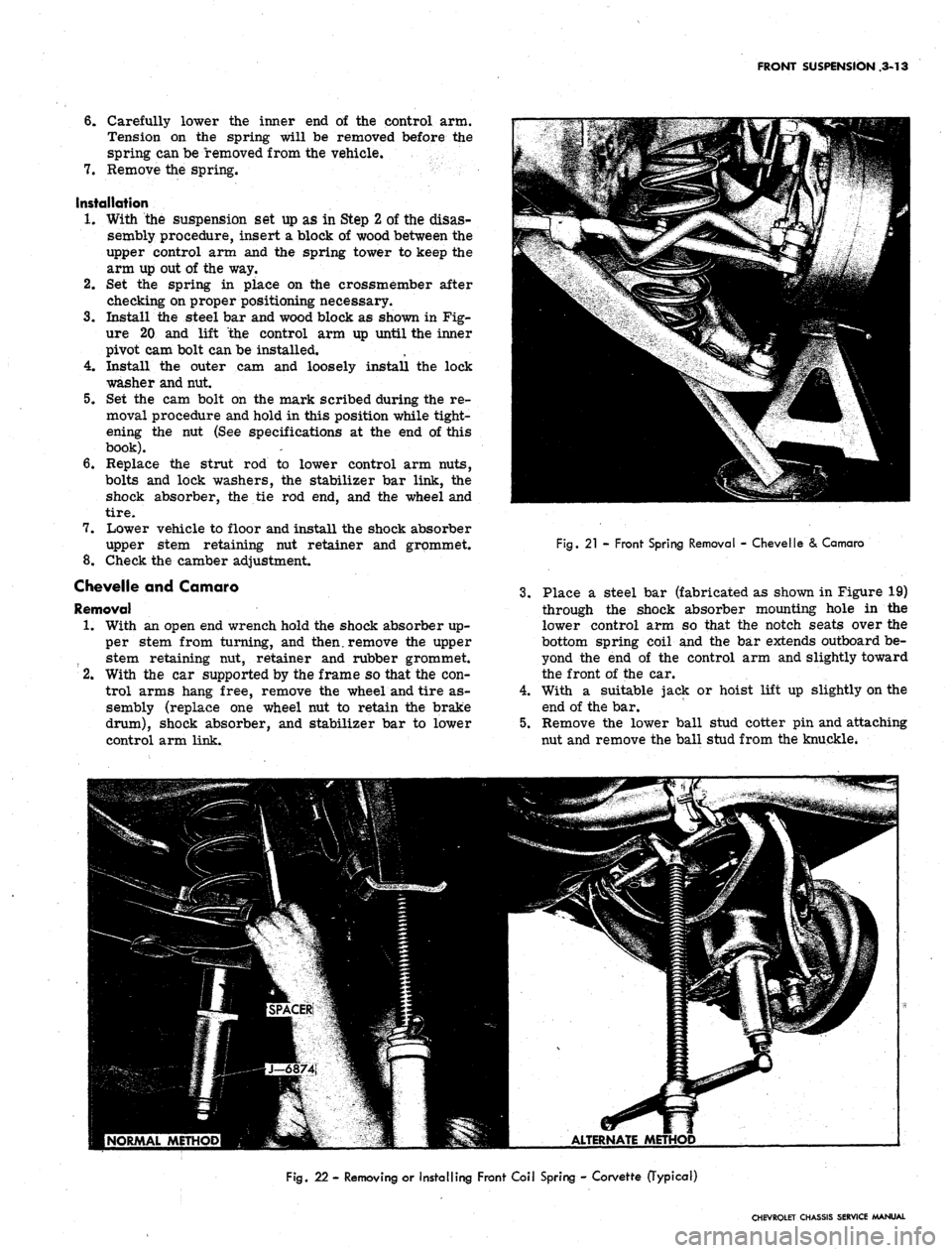
FRONT SUSPENSION ,3-13
6. Carefully lower the inner end of the control arm.
Tension on the spring will be removed before the
spring can be removed from the vehicle.
7.
Remove the spring.
Installation
1.
With the suspension set up as in Step 2 of the disas-
sembly procedure, insert a block of wood between the
upper control arm and the spring tower to keep the
arm up out of the way.
2.
Set the spring in place on the crossmember after
checking on proper positioning necessary.
3.
Install the steel bar and wood block as shown in Fig-
ure 20 and lift the control arm up until the inner
pivot cam bolt can be installed. ,
4.
Install the outer cam and loosely install the lock
washer and nut
5.
Set the cam bolt on the mark scribed during the re-
moval procedure and hold in this position while tight-
ening the nut (See specifications at the end of this
book).
6. Replace the strut rod to lower control arm nuts,
bolts and lock washers, the stabilizer bar link, the
shock absorber, the tie rod end, and the wheel and
tire.
7.
Lower vehicle to floor and install the shock absorber
upper stem retaining nut retainer and grommet.
8. Check the camber adjustment.
Chevelle and Camaro
Removal
1.
With an open end wrench hold the shock absorber up-
per stem from turning, and then, remove the upper
stem retaining nut, retainer and rubber grommet.
2.
With the car supported by the frame so that the con-
trol arms hang free, remove the wheel and tire as-
sembly (replace one wheel nut to retain the brake
drum),
shock absorber, and stabilizer bar to lower
control arm link.
4.
5.
Fig.
21 - Front Spring Removal - Chevelle & Camaro
Place a steel bar (fabricated as shown in Figure 19)
through the shock absorber mounting hole in the
lower control arm so that the notch seats over the
bottom spring coil and the bar extends outboard be-
yond the end of the control arm and slightly toward
the front of the car.
With a suitable jack or hoist lift up slightly on the
end of the bar.
Remove the lower ball stud cotter pin and attaching
nut and remove the ball stud from the knuckle.
ALTERNATE METHOD
Fig.
22 - Removing or Installing Front Coil Spring - Corvette (Typical)
CHEVROLET CHASSIS SERVICE MANUAL
Page 178 of 659
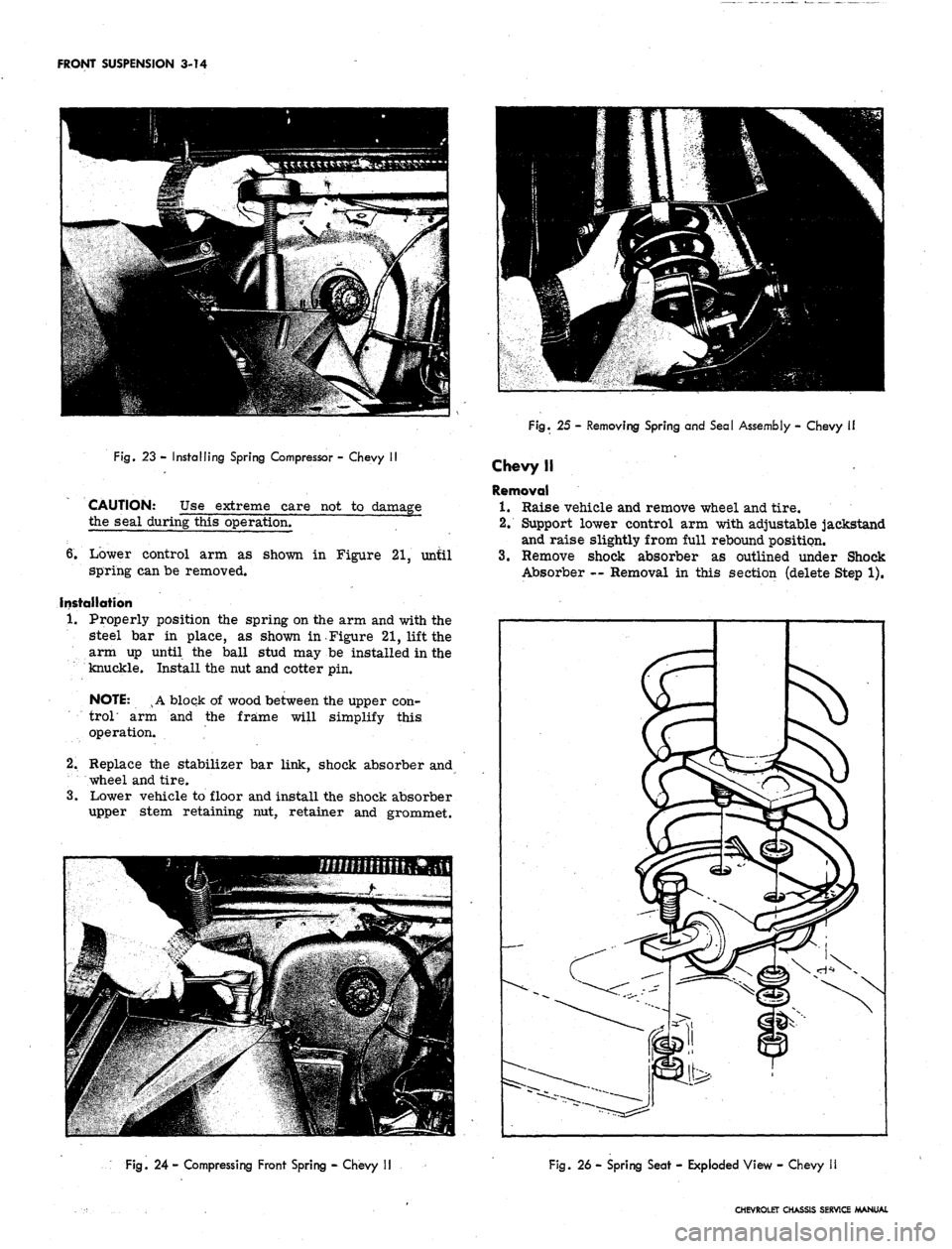
FRONT SUSPENSION 3-14
Fig.
23 - Installing Spring Compressor - Chevy II
CAUTION: Use extreme care not to damage
the seal during this operation.
6. Lower control arm as shown in Figure 21, until
spring can be removed.
Installation
1.
Properly position the spring on the arm and with the
steel bar in place, as shown in.Figure 21, lift the
arm up until the ball stud may be installed in the
knuckle. Install the nut and cotter pin.
NOTE:
^A block of wood between the upper con-
trol' arm and the frame will simplify this
operation.
2.
Replace the stabilizer bar link, shock absorber and
wheel and tire.
3.
Lower vehicle to floor and install the shock absorber
upper stem retaining nut, retainer and grommet.
Fig.
25 - Removing Spring and Seal Assembly - Chevy 11
ChevyiI
Removal
1.
Raise vehicle and remove wheel and tire.
2.
Support lower control arm with adjustable jackstand
and raise slightly from full rebound position.
3.
Remove shock absorber as outlined under Shock
Absorber -- Removal in this section (delete Step 1).
Fig.
24 - Compressing Front Spring - Chevy
Fig.
26 - Spring Seat - Exploded View - Chevy II
CHEVROLET CHASSIS SERVICE MANUAL
Page 179 of 659
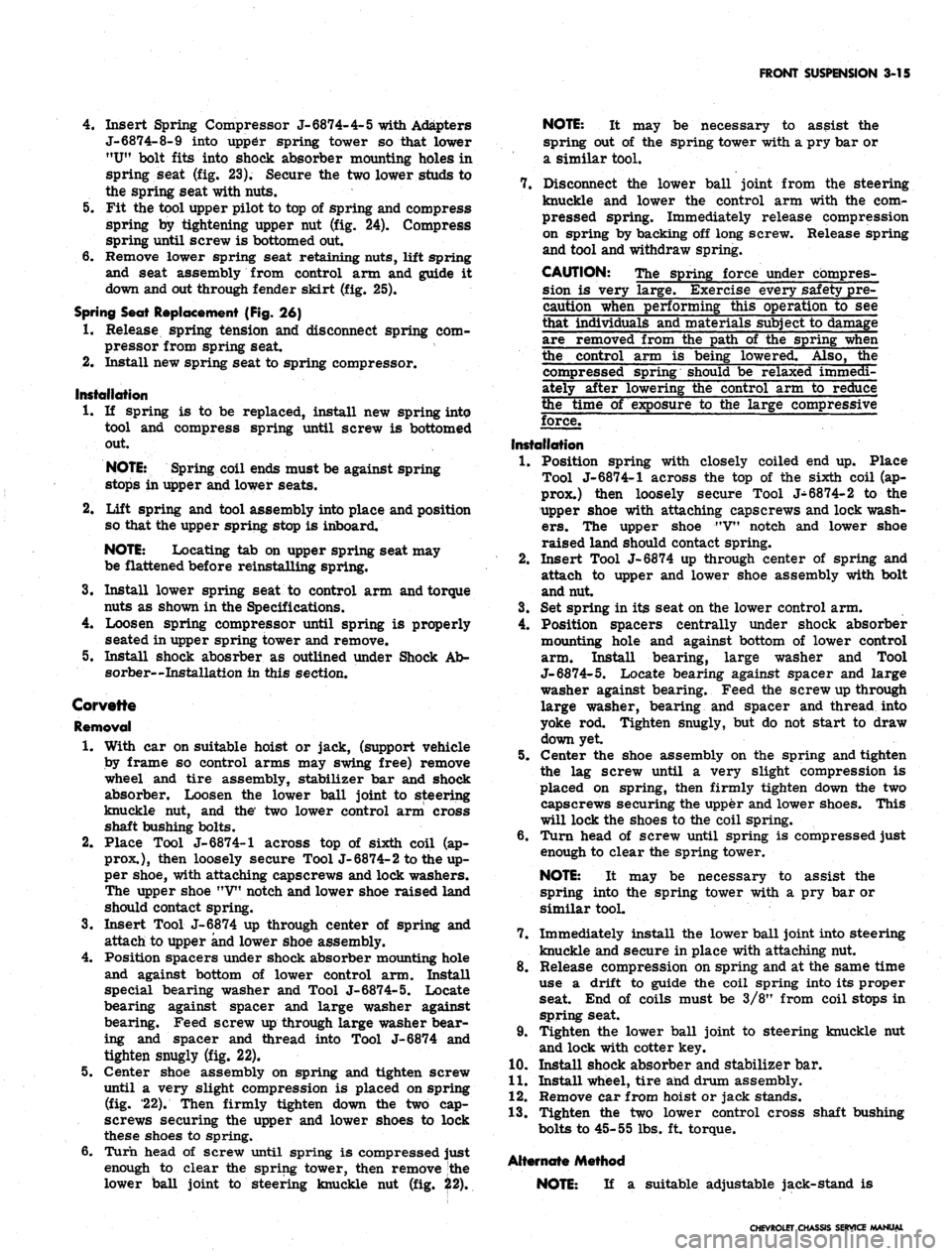
FRONT SUSPENSION 3-15
4.
Insert Spring Compressor J-
6874-
4-
5 with Adapters
J-6874-8-9 into upp^r spring tower so that lower
MU"
bolt fits into shock absorber mounting holes in
spring seat (fig. 23). Secure the two lower studs to
the spring seat with nuts.
5.
Fit the tool upper pilot to top of spring and compress
spring by tightening upper nut (fig. 24). Compress
spring until screw is bottomed out.
6. Remove lower spring seat retaining nuts, lift spring
and seat assembly from control arm and guide it
down and out through fender skirt (fig. 25).
Spring Seat Replacement (Fig. 26)
1.
Release spring tension and disconnect spring com-
pressor from spring seat.
2.
Install new spring seat to spring compressor.
Installation
1.
If spring is to be replaced, install new spring into
tool and compress spring until screw is bottomed
out.
NOTE: Spring coil ends must be against spring
stops in upper and lower seats.
2.
Lift spring and tool assembly into place and position
so that the upper spring stop is inboard.
NOTE: Locating tab on upper spring seat may
be flattened before reinstalling spring.
3.
Install lower spring seat to control arm and torque
nuts as shown in the Specifications.
4.
Loosen spring compressor until spring is properly
seated in upper spring tower and remove.
5.
Install shock abosrber as outlined under Shock Ab-
sorber—Installation in this section.
Corvette
Removal
1.
With car on suitable hoist or jack, (support vehicle
by frame so control arms may swing free) remove
wheel and tire assembly, stabilizer bar and shock
absorber. Loosen the lower ball joint to steering
knuckle nut, and the' two lower control arm cross
shaft bushing bolts.
2.
Place Tool J-6874-1 across top of sixth coil (ap-
prox.),
then loosely secure Tool J-6874-2 to the up-
per shoe, with attaching capscrews and lock washers.
The upper shoe "V" notch and lower shoe raised land
should contact spring.
3.
Insert Tool J-6874 up through center of spring and
attach to upper and lower shoe assembly.
4.
Position spacers under shock absorber mounting hole
and against bottom of lower control arm. Install
special bearing washer and Tool J-6874-5. Locate
bearing against spacer and large washer against
bearing. Feed screw up through large washer bear-
ing and spacer and thread into Tool J-6874 and
tighten snugly (fig. 22).
5.
Center shoe assembly on spring and tighten screw
until a very slight compression is placed on spring
(fig. '22). Then firmly tighten down the two cap-
screws securing the upper and lower shoes to lock
these shoes to spring.
6. Turn head of screw until spring is compressed just
enough to clear the spring tower, then remove the
lower ball joint to steering knuckle nut (fig. 22).
NOTE: It may be necessary to assist the
spring out of the spring tower with a pry bar or
a similar tool.
7.
Disconnect the lower ball joint from the steering
knuckle and lower the control arm with the com-
pressed spring. Immediately release compression
on spring by backing off long screw. Release spring
and tool and withdraw spring.
CAUTION: The spring force under compres-
sion is very large. Exercise every safety pre-
caution when performing this operation to see
that individuals and materials subject to damage
are removed from the path of the spring when
the control arm is being lowered. Also, the
compressed spring
be relaxed immedi-
ately after lowering the control arm to reduce
the time of exposure to the large compressive
force.
Installation
1.
Position spring with closely coiled end up. Place
Tool J-6874-1 across the top of the sixth coil (ap-
prox.) then loosely secure Tool J-6874-2 to the
upper shoe with attaching capscrews and lock wash-
ers.
The upper shoe MV" notch and lower shoe
raised land should contact spring.
2.
Insert Tool J-6874 up through center of spring and
attach to upper and lower shoe assembly with bolt
and nut.
3.
Set spring in its seat on the lower control arm.
4.
Position spacers centrally under shock absorber
mounting hole and against bottom of lower control
arm. Install bearing, large washer and Tool
J-6874-5.
Locate bearing against spacer and large
washer against bearing. Feed the screw up through
large washer, bearing and spacer and thread into
yoke rod. Tighten snugly, but do not start to draw
down yet
5.
Center the shoe assembly on the spring and tighten
the lag screw until a very slight compression is
placed on spring, then firmly tighten down the two
capscrews securing the upper and lower shoes. This
will lock the shoes to the coil spring.
6. Turn head of screw until spring is compressed just
enough to clear the spring tower.
NOTE: It may be necessary to assist the
spring into the spring tower with a pry bar or
similar tool.
7.
Immediately install the lower ball joint into steering
knuckle and secure in place with attaching nut.
8. Release compression on spring and at the same time
use a drift to guide the coil spring into its proper
seat. End of coils must be 3/8" from coil stops in
spring seat.
9. Tighten the lower ball joint to steering knuckle nut
and lock with cotter key.
10.
Install shock absorber and stabilizer bar.
11.
Install wheel, tire and drum assembly.
12.
Remove car from hoist or jack stands.
13.
Tighten the two lower control cross shaft bushing
bolts to 45-55 lbs. ft. torque.
NOTE: If a suitable adjustable jack-stand is
CHEVROLET CHASSIS SERVICE MANUAL
Page 180 of 659
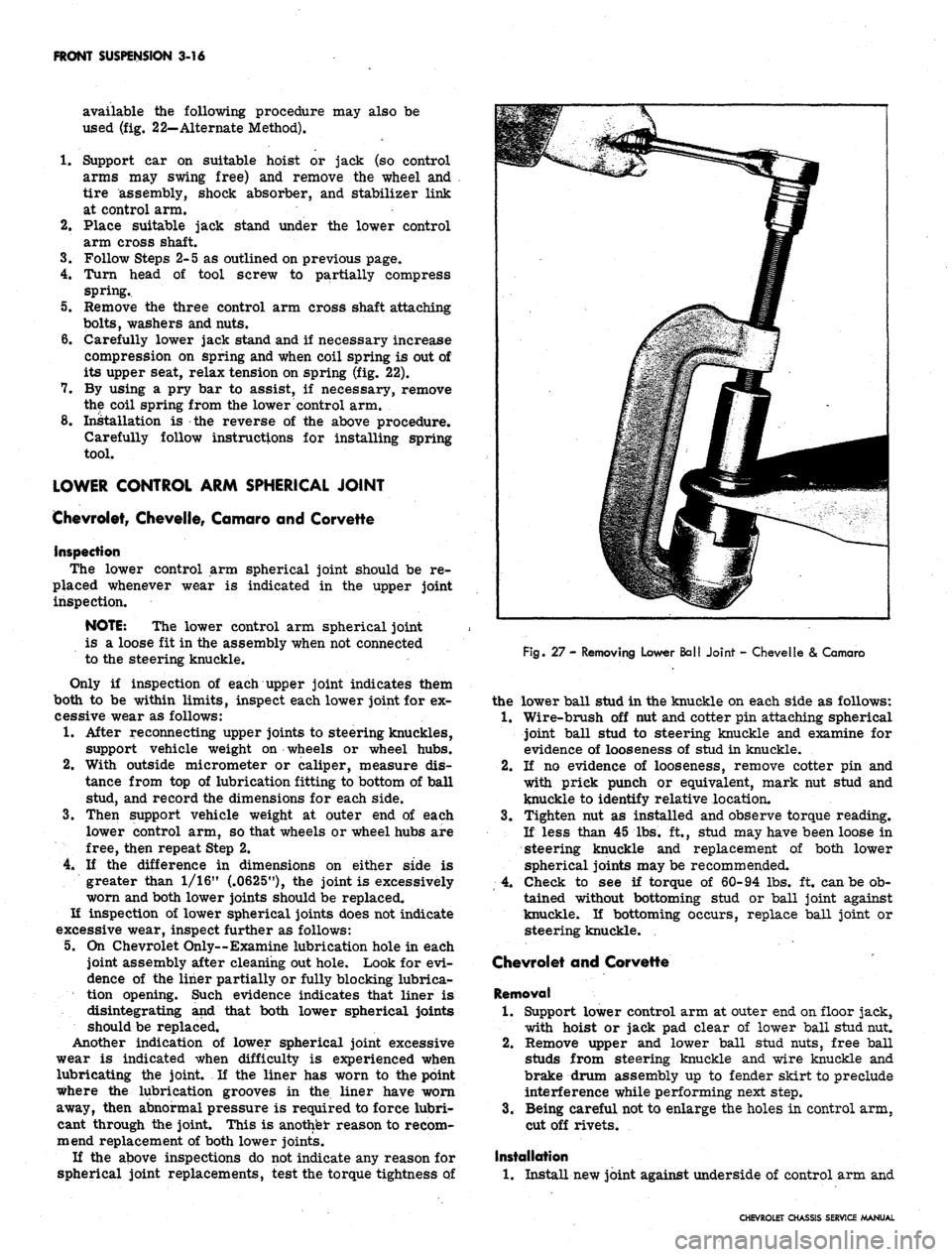
FRONT SUSPENSION 3-16
available the following procedure may also be
used (fig. 22-Alternate Method).
1.
Support car on suitable hoist or jack (so control
arms may swing free) and remove the wheel and
tire assembly, shock absorber, and stabilizer link
at control arm.
2.
Place suitable jack stand under the lower control
arm cross shaft.
3.
Follow Steps 2-5 as outlined on previous page.
4.
Turn head of tool screw to partially compress
spring.
5. Remove the three control arm cross shaft attaching
bolts,
washers and nuts.
6. Carefully lower jack stand and if necessary increase
compression on spring and when coil spring is out of
its upper seat, relax tension on spring (fig. 22).
7. By using a pry bar to assist, if necessary, remove
the coil spring from the lower control arm.
8. Installation is the reverse of the above procedure.
Carefully follow instructions for installing spring
tool.
LOWER CONTROL ARM SPHERICAL JOINT
Chevrolet, Chevelle, Comoro and Corvette
Inspection
The lower control arm spherical joint should be re-
placed whenever wear is indicated in the upper joint
inspection.
NOTE: The lower control arm spherical joint
is a loose fit in the assembly when not connected
to the steering knuckle.
Only if inspection of each upper joint indicates them
both to be within limits, inspect each lower joint for ex-
cessive wear as follows:
1.
After reconnecting upper joints to steering knuckles,
support vehicle weight on wheels or wheel hubs.
2.
With outside micrometer or caliper, measure dis-
tance from top of lubrication fitting to bottom of ball
stud, and record the dimensions for each side.
3.
Then support vehicle weight at outer end of each
lower control arm, so that wheels or wheel hubs are
free,
then repeat Step 2.
4.
If the difference in dimensions on either side is
greater than 1/16" (.0625"), the joint is excessively
worn and both lower joints should be replaced.
If inspection of lower spherical joints does not indicate
excessive wear, inspect further as follows:
5.
On Chevrolet Only--Examine lubrication hole in each
joint assembly after cleaning out hole. Look for evi-
dence of the liner partially or fully blocking lubrica-
tion opening. Such evidence indicates that liner is
disintegrating and that both lower spherical joints
should be replaced.
Another indication of lower spherical joint excessive
wear is indicated when difficulty is experienced when
lubricating the joint. If the liner has worn to the point
where the lubrication grooves in the liner have worn
away, then abnormal pressure is required to force lubri-
cant through the joint. This is another reason to recom-
mend replacement of both lower joints.
If the above inspections do not indicate any reason for
spherical joint replacements, test the torque tightness of
Fig. 27 - Removing Lower Ball Joint - Chevelle
&
Camaro
the lower ball stud in the knuckle on each side as follows:
1.
Wire-brush off nut and cotter pin attaching spherical
joint ball stud to steering knuckle and examine for
evidence of looseness of stud in knuckle.
2.
If no evidence of looseness, remove cotter pin and
with prick punch or equivalent, mark nut stud and
knuckle to identify relative location.
3.
Tighten nut as installed and observe torque reading.
If less than 45 lbs. ft., stud may have been loose in
steering knuckle and replacement of both lower
spherical joints may be recommended.
4.
Check to see if torque of 60-94 lbs. ft. can be ob-
tained without bottoming stud or ball joint against
knuckle. If bottoming occurs, replace ball joint or
steering knuckle.
Chevrolet and Corvette
Removal
1.
Support lower control arm at outer end on floor jack,
with hoist or jack pad clear of lower ball stud nut.
2.
Remove upper and lower ball stud nuts, free ball
studs from steering knuckle and wire knuckle and
brake drum assembly up to fender skirt to preclude
interference while performing next step.
3.
Being careful not to enlarge the holes in control arm,
cut off rivets.
Installation
1.
Install new joint against underside of control arm and
CHEVROLET CHASSIS SERVICE MANUAL